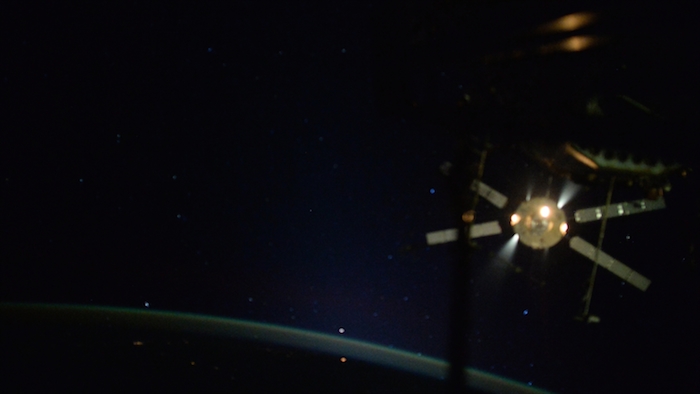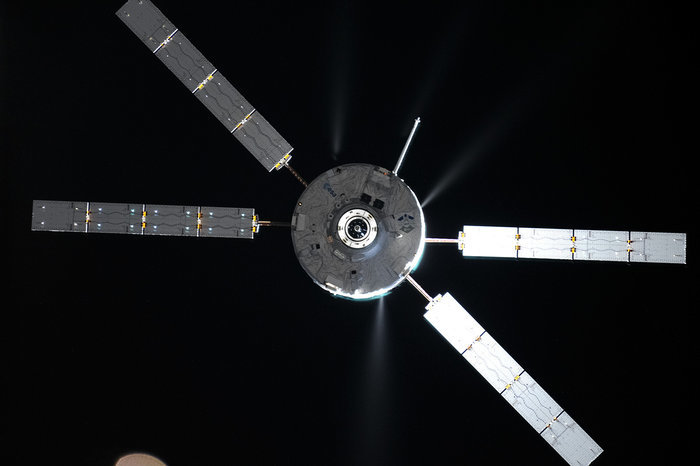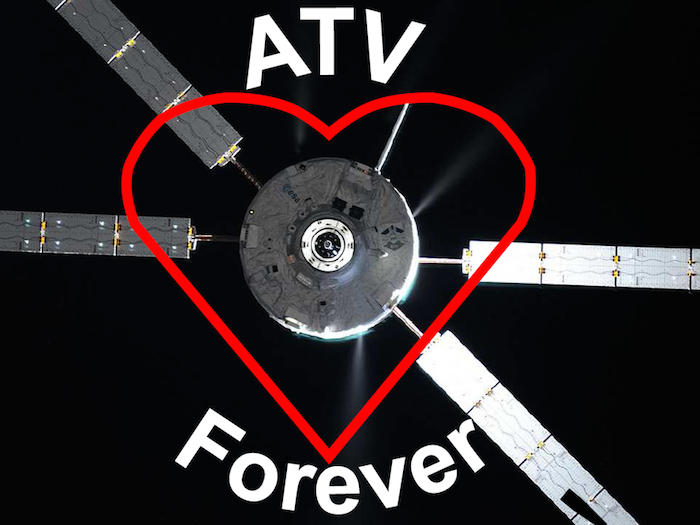Abschied vom ATV: Raumfahrzeug "Georges Lemaître" verglüht über dem Südpazifik

Es ist ein Abschied für immer: Am 15. Februar 2015 ist um 19.04 Uhr mitteleuropäischer Zeit das fünfte und letzte europäische Raumfahrzeug ATV (Automated Transfer Vehicle) mit dem Namen "Georges Lemaître" kontrolliert in die Erdatmosphäre eingetreten und verglüht. Zuvor hatte es Nachschub und Experimente zur Internationalen Raumstation ISS transportiert sowie deren Bahn angehoben und korrigiert. Mit seinem Ausscheiden ist zwar die Ära der ATV-Transporter zu Ende - doch ihr Knowhow wird im europäischen Servicemodul der US-amerikanischen Raumkapsel Orion weiterleben.
Feuriges Finale im Taumelflug
Einen Tag zuvor, am 14. Februar, hatte ATV-5 um 14.40 Uhr mitteleuropäischer Sommerzeit vom russischen Swesda-Modul der Raumstation abgedockt und Kurs auf die Erde genommen. Zwei gezielte Bremsmanöver sorgten vor dem Wiedereintritt dafür, dass der 20-Tonnen-Transporter in einem steilen Winkel in die Erdatmosphäre eintauchte, um dann zu verglühen. Das zusätzliche Zünden der Steuerdüsen brachte das Fahrzeug zum Taumeln und erleichterte so das Auseinanderbrechen in kleinere Einzelteile. Drei Wiedereintritts-Experimente zeichneten während des so genannten Reentries Daten auf, wie beispielsweise die Temperaturentwicklung, und sendeten diese zur Erde. Eines davon ist der schon zuvor eingesetzte "Reentry Break up Recorder" - eine Art Flugschreiber, der mechanische Lasten aufzeichnet. Er wurde jetzt von einer optischen und einer Infrarot-Kamera ergänzt. Diese übermittelten die Bilder vom Beginn des Wiedereintritts bis zum Auseinanderbrechen des ATV.
Der ursprünglich von der Europäischen Weltraumorganisation ESA geplante "Shallow Reentry", ein Wiedereintritt in die Erdatmosphäre mit flachem Winkel, wurde aus Sicherheitsgründen nicht durchgeführt. Vor einigen Tagen war eine Batterie in einem der vier redundanten Energieversorgungsstränge ausgefallen.
LIRIS verbessert das automatische Andocken
Am 30. Juli 2014 mitteleuropäischer Sommerzeit war ATV-5 mit eine Ariane-5-Trägerrakete vom Weltraumbahnhof Kourou in Französisch-Guayana zur ISS gestartet. An Bord befanden sich dabei Nachschub an Wasser, Treibstoff, Atemluft und Lebensmittel, der vom Deutschen Zentrum für Luft- und Raumfahrt (DLR) entwickelte Schmelzofen EML sowie die ebenfalls aus Deutschland stammende Experimente MagVector, Spacetex und WiseNet. Vor dem Andocken an die Raumstation am 12. August, das der deutsche ESA-Astronaut Alexander Gerst und der russische Kosmonaut Alexander Skvortsov überwachten, wurden erstmalig die neuen Rendezvous-Sensoren LIRIS (Laser InfraRed Imaging Sensors) am ATV getestet. Diese weiterentwickelte Kombination aus Laser- und Infrarot-Technologie soll zukünftige robotische Anwendungen, wie etwa die Entsorgung von Weltraummüll, ermöglichen und optimieren helfen.
Umittelbar nach dem Andocken begann die Crew mit dem Entladen des Transporters. Das mit über 300 Kilogramm größte der Experimente, den elektromagnetischen Levitator EML, baute Alexander Gerst ins "European Drawer Rack" des Columbus-Labors ein und begann mit dem Testbetrieb. In dem Schmelzofen, in dem metallische Legierungen frei schwebend aufgeschmolzen und analysiert werden können, sollen in den kommenden Monaten Experimente mit 18 verschiedenen Metallproben durchgeführt werden. EML liefert dabei hochgenaue Daten, die beispielsweise die Simulation von Gießvorgängen in der Metallproduktion entscheidend verbessern können.
ATV ist Geschichte, mit Orion geht es weiter
Mit "Georges Lemaître“ gehört das letzte ATV der Vergangenheit an - doch seine Technologie lebt weiter: Sie wird im europäischen Servicemodul ESM der US-amerikanischen Raumkapsel Orion verwendet. ESM ist dort für Energie, Antrieb und Temperaturkontrolle der Raumkapsel, aber auch für die Lagerung von Versorgungsgütern verantwortlich. Das Servicemodul ist außerdem ein so genanntes Barter-Element, das heißt, es sichert den Europäern Nutzungsrechte auf der ISS in den Jahren 2017 bis 2020.
Orion soll erstmals 2018 unbemannt getestet werden und zunächst den Mond, in zukünftigen Missionen aber auch Objekte im erdfernen Weltraum, wie etwa Asteroiden, erforschen. Mit dem ESM steuert die ESA erstmalig ein solch hochkomplexes und kritisches Element zu einer wichtigen US-Mission bei - ein großer Vertrauensbeweis, der durch das erfolgreiche ATV-Programm erst ermöglicht wurde. Entwickelt und gebaut wird ESM, wie auch zuvor das ATV, vom Raumfahrtunternehmen Airbus Defence and Space in Bremen.
Das Ende einer Ära
Mit seinem fünften erfolgreichen Flug habe das ATV alle Erwartungen an das Programm mehr als erfüllt, sagt Volker Schmid, ATV-Programmverantwortlicher beim Raumfahrtmanagement des Deutschen Zentrums für Luft- und Raumfahrt (DLR): "Der europäische Raumtransporter führte alle vollautomatischen Flüge und Andockmanöver in bisher nicht erreichter Präzision durch - allein das punktgenaue Andocken an die ISS bei 28.000 Stundenkilometern war eine große Herausforderung, die es zu meistern galt. Zudem ist ATV das größte und komplexeste Raumfahrzeug, das bislang für den Raumtransport eingesetzt wurde." ATV-1 "Jules Verne" startete 2008 zur Raumstation. Danach folgten "Johannes Kepler" (2011), "Edoardo Amaldi" (2012), "Albert Einstein" (2013) und "Georges Lemaître" (2014). Insgesamt wurden bei den fünf Flügen 31,5 Tonnen Fracht zur ISS transportiert. Mit den ATV-Flügen hat Europa seine Beteiligung an den allgemeinen Betriebskosten der ISS abgeleistet. Dadurch erhalten deutsche und andere europäische Astronauten, Wissenschaftler und Ingenieure entsprechende Nutzungszeit auf der ISS.
Mit dem Bau und der Entwicklung des ATV habe die europäische Raumfahrtindustrie wichtige Kenntnisse und Fähigkeiten sammeln und ihren hohen Technologiestandard unter Beweis stellen können, erläutert DLR-Experte Volker Schmid: "Deutschland war dabei federführend am Programm beteiligt und hat rund 48 Prozent der Beiträge des insgesamt drei Milliarden teuren Programms finanziert." Für de unter Federführung von Airbus Defense & Space in Bremen gebauten Transporter haben 30 Firmen aus zehn europäischen Ländern Leistungen erbracht, weitere Beiträge stammten aus Russland und den USA. Auch das DLR war maßgeblich am Programm beteiligt: So betreute das DLR Raumfahrtmanagement das Programm, beim deutschen Raumfahrtkontrollzentrum beim DLR in Oberpfaffenhofen wurde die Kommunikation zwischen dem ISS-Kontrollzentrum in Moskau und dem ATV-Kontrollzentrum in Toulouse koordiniert, und das DLR in Göttingen hatte die ATV-Steuerdüsen mitentwickelt.
Quelle: DLR
-

Mission: A multi-instrument airborne campaign to monitor the shallow reentry of ESA's 5th, and final, Automated Transfer Vehicle over the south Pacific ocean to better understand the physics of the end of life International Space Station de-orbit and the physics of shallow uncontrolled reentries.

Ten of the 31-person strong ATV5 team during upload, ready to deploy in a next opportunity. From left to right: Ron Dantowitz (Dexter Southfield), Fabian Zander (U. Stuttgart), Ferdinand Fahlbush (Astos), Thomas Marynowski (U. Stuttgart), Marek Kozubal (Dexter Southfield), Stefan Loehle (U. Stuttgart), Peter Jenniskens (SETI Institute), Sven Weikert (Astos), Dave Buttsworth (U. Southern Queensland), and Forrest Gasdia (Embry Riddle Aeronautical University).

As a final effort to be prepared for the next shallow reentry opportunity, our team met at 4 am this morning to perform instrument checks, using calibration lamps at the far end of the darkened hangar. Later that morning the instruments and their racks were unloaded and readied for shipment home. It was a very sad moment to walk one last time through the DC8 aircraft, making sure nothing was left behind. The last item to collect was our mission logo sign at the bottom of the stairs.

Our flight has been postponed. This morning, we investigated the possibility of performing a daytime reentry observation campaign to Tahiti on Sunday February 15. Jim calculated the new observation point and found it was not far from where we would have been on Feb 27, even closer to Tahiti. We made sufficient progress with the DC8 preparations to not have a significant show stopper there either.
However, the objective of the ATV5 Reentry Observation Campaign was to study the physics and dynamics of shallow reentries relevant to the ISS de-orbit and it was decided this morning that the remaining funds for such a study be better saved for a next observation attempt during a future controlled reentry of another (necessarily smaller) spacecraft. Those already arrived at AAOF are finishing work today and tomorrow to improve our instrument installations so we are ready for this next opportunity.
Quelle: SETI INSTITUTE
---
Update: 21.45 MEZ
Sam CristoforettiVerifizierter Account
@AstroSamantha
Good bye #ATV5! Arrivederci ATV5!
.
Great view of ATV-5 smoke trail
Posted on 15 Feb 2015 by Daniel
And on board the ISS, astro Terry also grabbed an amazing photo of ATV-5 reentry!
Terry W. Virts ✔ @AstroTerry
Final view #ATV5 Georges Lemaître entering Earth's atmosphere. It was surprising to see how high the smoke trail was.
.
ATV forever
This was the last image shown on the ATV Control Centre's main screen after the last reentry ever of an Automated Transfer Vehicle. The technology in ATV will go to space again in 2017 on NASA's Orion spacecraft.
.
Last screen shown at the ATV control centre before being switched off.
Quelle: ESA

Jamais l'ATV-CC avait été aussi rempli. Crédits : CNES/Frédéric Maligne

































